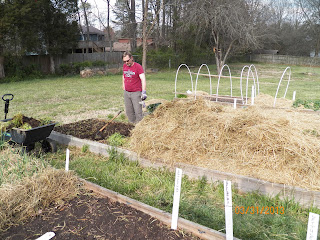written by Yvonne
This post is an accumulation of about three weeks worth of gardening work. Instead of writing about it by the week, it's categorized by areas of the garden.
GARLIC
The grass had grown SUPER high around the garlic and it was gonna take some time to dig through and determine what of the tall green stuff was grass and what was garlic.
Describing this as similar to finding a needle in a haystack may be a slight exaggeration, but not by much. The garlic looked ever so slightly different from the grass. The grass was so intermixed, it wasn't possible to pull the grass out without disturbing the garlic, so I oped to just cut the grass as close to the soil as possible.
Last step was to put hay around each bulb of garlic. Whew! What a job. If Ruth Stout's hay mulching works, I'll never have to do that again.
POTATOES AND ONIONS
This area is where we've grown potatoes before. Last season, we planted both onions and potatoes but the onions never took off. Or so we thought....
Upon closer inspection, there are onions growing here (kinda hard to see in this picture, but they're there). We started a round of onions in pots this year and Tom added them to this patch as well.
I threw the potatoes on one end of the potato/onion bed and then covered them with a thick layer of hay. We'll see if they spout this way or now. It'll be SO cool if they do! (I have doubts.)
PEAS
Granted, it has been cold, but gosh darn it these peas are taking their sweet time. This big white ball in the photo is the pea seed pushing out of the ground ready to open up.
Here is one that has shed its outer hull and started to actually sprout.
NEW PLANTINGS (IN POTS)
Time for even more seeds to go into the greenhouse.
All the herbs, tomatoes, peppers, cucumbers and round two of broccoli, kale, and more greens are all in pots now.
The first round of collards, kale, onions and broccoli are doing pretty good at this point.
PARSLEY
I'd uncovered a parsley plant no too long ago. It sure is great to have such flavorful parsley at the ready when cooking! I spread another row's worth of seeds next to it so there would be plenty through the spring and summer.
COLLARDS
After putting the hay down just a few weeks ago, the collards, spinach and cabbage grew significantly and they all turned greener. I couldn't believe how much of an impact the hay has made in such a short time! Since the second round of collards had sprouted in pots and was read to plant, I thought the best thing to do would be to...
pull all the collards out and make space for the new seedlings. So I did just that. Once the plants were pulled up...
I pushed the hay to one side...
and carefully separated the seedlings from one another and planted them in the space where the previous collards had been.
And now it looks like this.
And here's how much I pulled up. Three baskets full!
Tom and I made an assembly line to blanch the greens and set them in 10oz nests for freezing. We were able to get 5 10oz nests out of the three baskets full.
BERRIES
We blinked and all of a sudden the berries started blooming. These are canes that didn't produce berries last year and supposedly they will produce berries this year.
We didn't get all of the canes cut back and now (obviously) it's too late cut them. So we may just wake up one morning to find our cars completely surround by fast-growing raspberry and blackberry canes.
DIRECT SOWING
Several items do better by sowing them directly (versus starting them in pots) so Tom got to work doing some direct sowing. First thing he had to do was clear the hay completely off the planting area. When planting seeds direct, you have to get them at least to touch the dirt.
Once the hay was removed, he sprinkled seeds in the dirt and patted them down.
Here is a nice half-bed worth of lettuces...
and another quarter of a bed of spinach, carrots and beets.
Once the seeds sprout, we'll pull the hay around the plants, like we did for the spinach and collards.
There's lots of activity going on with T's Bees these days. If you want to read all the buzz, go to www.tsbeeshoney.com. Also, if you want to know when the 2013 crop of honey is ready for purchase, click on the Contact Ts Bees page and fill out the form.


























